Knee pain is one of the most common areas of complaint in youth athletics. If you haven’t experienced knee pain yourself, then you probably know someone who has. Knee pain presents in a variety of ways – sharp, dull, achy, unstable, stiff – and in various areas of the knee – front (anterior), back, inside, outside, above, below. In Part I of this article, I explain some of the common causes of anterior knee pain that youth athletes may experience, including Patellofemoral Pain Syndrome, Patellar Tendonitis, Pes Anserine tendonitis/bursitis, and Osgood Schlatters Disease; in Part II, I offer helpful tips for prevention and treatment for these conditions.

Patellofemoral Pain Syndrome (PFPS) involves irritation of the cartilage under the kneecap (patella), as it interacts with and contacts the bone beneath it, called the femur. Early on, pain may be associated with inflammation or softening of the cartilage, but as compression continues and the cartilage breaks down, arthritis may eventually develop. Pain may be vague in location or appear to move around, but is generally localized to the medial or lateral side of the kneecap. Many people suffering from pain and inflammation consider alternative natural products to help them cope with and also relieve the effects they’re dealing with which might include things like marijuana – Click here to learn about such products which many have claimed to be beneficial to their situation.
Quite often, there are multiple factors that contribute to PFPS, which may include some of the following: tight iliotibial band (ITB), hamstrings, or quadriceps muscles; patella resting in a lateral tilt position; weakness of the gluteals and deep hip stabilizing muscles; or dysfunctional biomechanics with running and jumping, resulting in abnormal tracking or pressure on the patella. PFPS generally continues to worsen until the appropriate factors are addressed and normalized. Look for a future article from me on Patellofemoral Pain Syndrome, as it is extremely common in all age groups and a very interesting topic to discuss.
Patellar Tendonitis consists of inflammation and irritation at the upper portion of the Patellar Tendon, which is in the front of the knee and attaches the kneecap (patella) to the lower leg bone (tibia). Pain is often felt at the lower tip of the kneecap and into the tendon below. The knee may feel tight initially, and painful when running downhill or descending stairs. In early stages, the pain may subside after warming up, but eventually the tendon breakdown will worsen, causing cellular changes and degradation of the tissue. Those looking for an alternative solution to managing pain may want to consider natural products like cannatek products which many enjoy taking because of the beneficial effects that they experience, helping them to cope with pain and inflammation as well as mental health concerns too!
Contributing factors may include tightness of the hamstrings and quadriceps, lack of eccentric quadriceps strength, and poor shock absorption and landing control from the core, hips, and lower extremity. Improper training progression may also contribute by increasing the demand on the tendon faster than the body can develop appropriate tolerance.

The Pes Anserine is the conjoining tendon of three muscles that cross the medial knee and attach to the front/inside of the upper tibia. These three muscles work together to control abnormal rotational movement at the knee. Poor stability at the hip and foot, combined with increased running or training, are often the culprits of Pes Anserine tendonitis or bursitis. The pain is localized over the anteromedial lower knee and may be tender to the touch.
Osgood Schlatters Disease usually strikes adolescents during a growth spurt, when bones are lengthening faster than muscles. More specifically, Osgood Schlatters Disease involves irritation of the patellar tendon attachment to the lower leg, on a boney prominence called the tibial tuberosity. When the bones are growing rapidly, the patellar tendon pulls on the tibial tuberosity, causing pain.
The risk is greater if the child is also participating in a sport or activity with a lot of jumping, running, and changing directions. The tibial tuberosity may become enlarged and tender to the touch. The condition may resolve on its own in 1-2 years, although improving lower extremity flexibility, specifically the quadriceps, will be beneficial in reducing the force, decreasing pain, and resolving the issue more quickly.
In Part II, I reveal helpful tips to prevent and resolve these common sources of knee pain.





